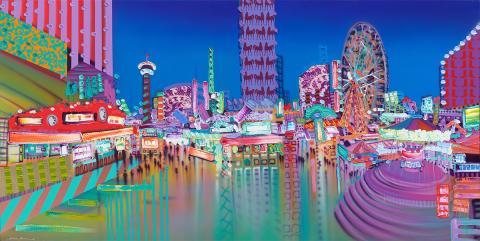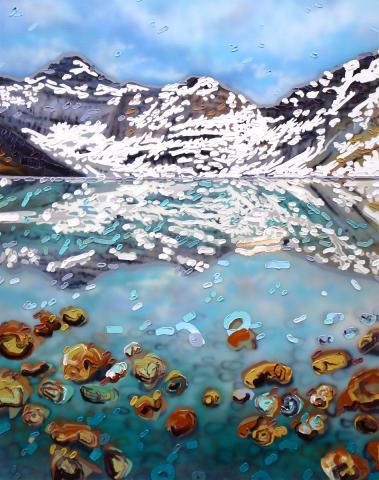BFA IN PAINTING, 2006
ALUMNI DISCOVERY INITIATIVE, INTERVIEW BY ARKATYISS MILLER, 2015

See you at the Stampede (2015), mixed media on canvas, 30 x 60"
Arkatyiis MILLER: When did you graduate ACAD? What was your major? Do you continue to work in this area or did you change areas of interest?
Sheila KERNAN: I graduated from the ACAD in 2006 with a painting major. My main focus is still painting, but I also dabble in 2D and 3D sculpture.
MILLER: A lot of graduates use the ACAD degree as a creative stepping stone. So, what do you do? How has what you do evolved since graduation? How did your education at ACAD direct your career?
KERNAN: I thought that having a BFA would be a stepping stone degree; I actually wanted to study architecture. I always loved painting, but I didn’t realize until I went to ACAD that it could be a viable career. I discovered that arts degrees are valuable in terms of what employers look for… having a BFA says a lot about having a creative mind and being able to problem solve. Employers like that.
As I said, I studied painting, and I still work with paint. I wasn’t always painting full time. At first I had a full time job on top of painting, but I was able to focus solely only painting full time within two years of graduating. Painting full time involves even more deadlines and pressure than school – all of the deadlines from ACAD were a tremendous teaching tool for me. You have to learn to deal with constant pressure; this was something I began to learn at ACAD but is even more intense once you start your career outside the school. I love it!
I wanted to study fashion design, interior design, architecture… pretty much anything arts related. The longer I studied painting in art school, the more I realized that anything creative would be difficult, so I chose painting, the discipline that I was most passionate about. Further education and self-directed studies reinforced and reaffirmed that I was passionate about painting, so I stuck with it.

Beside Still Waters (2013), mixed media on canvas, 60" X 48"
MILLER: What would you like to be recognized for?
KERNAN: Everyone wants recognition, but I just kind of want to paint. I just want to be able to paint what I see in my head, what I envision, and to see how far I can push the boundaries of my medium. I guess I want to be recognized for being innovative within my practice. I am always pushing my boundaries and seeing what I can do next.
MILLER: Given your experience, what advice would you give a student when it comes to establishing a creative business?
KERNAN: Business and art are two separate things. You have to be able to create that boundary for yourself. I would advise graduates to wait to jump into the business part until you’re actually ready. Take the time to be the best artist you can be, hone your craft, because you may not have the intense focus art school provides when you have to juggle work, creating, promoting and administration.
You’re so green when you first graduate from ACAD, there’s really no need to worry about business so fast. As Don Kottmann (former ACAD faculty) would say: “You can’t put the icing on the cake until you’ve made the cake”. So make the cake…perfect your craft, reflect on what your interests were while at ACAD and take the time to make sure it will be something you love for years to come. Your work should have lots of avenues to explore. It should be multidimensional. That way you will never feel like you are repeating things.

You Caught My Eye, oil and acrylic on canvas, 36 x 36"
I would suggest to anyone serious about making art their business or livelihood to take a 6-month business course after art school. Be involved with your local arts communities and jump on opportunities. Be honest and true to yourself about which avenue you want to go down. Ask yourself for each opportunity: does this make sense? Success doesn’t look the same for everyone, but whatever works for you is valid.
MILLER: What insights did your three years at ACAD give you when looking at things?
KERNAN: Art school didn't teach me how to paint, it showed me WHY I paint. It helped me to appreciate the concept behind my work, and to generally appreciate conceptual art. Don't be afraid if you don’t find yourself within your time at ACAD; there’s lots of time to do this later.
MILLER: After graduation, what obstacles did you encounter and how did you overcome them?
KERNAN: My greatest obstacle was a fear of believing in myself. It’s difficult to put yourself out there, for example when approaching galleries. Coping with rejection is really hard, but is a reality of the world outside of ACAD. But always remember that a no in one place means there’s a yes somewhere else. If you can, ask peers and galleries for feedback when you get rejected. Sometimes you need a “no” to understand how you can present yourself better next time.
There were also financial obstacles after I graduated. I was worrying a lot about how to make this — painting — into a career. All I can say is to just believe in yourself and keep investing in yourself. Support yourself with a side job if need be. Do whatever it takes to continue to create.
Remaining relevant and having an audience is another obstacle. The pressure gets more intense the longer your career goes on; make sure you are ready for this. It can be a real emotional rollercoaster.
MILLER: How could you imagine ACAD supporting our alumni?
KERNAN: I think ACAD could support graduates through promotion. For example, at some point after you leave ACAD there could be opportunities for collaboration, where alumni promote the school, and ACAD promotes the artist.
I also think ACAD has a job to raise awareness about its graduates. Who are the successful alumni? This should be a wide variety of alumni represented from different fields, not just new and emerging! Continual support is key to keeping artists relevant and making their best work.

One Orange Tree, mixed media, 3D sculptural painting on laser cut aluminium and aluminium panels, 40 x 36"
MILLER: What do you feel is the role of ACAD and our alumni in shaping our cultural and economic prosperity?
KERNAN: These are two really different things. It’s our responsibility to educate those who are not familiar with art in order to promote awareness of its importance and value. I think artists and ACAD should do all they can to help expose others to art who would have never otherwise been attracted to, or surrounded by, art.
It's also our job as artists to produce work that’s engaging. Creating work that is more accessible — an I am not saying this means your ideas can’t be complex — allows people to understand tremendous value of art. I think that this would be big in bringing the excitement of art to other people’s lives.
I have seen that evolution towards appreciating art in my own group of friends. I bring them in thorough accessibility, take them towards art appreciation in baby steps. Openness comes from experience, and eventually you will see all sorts of people open up to art if they are given the time.
Always know your audience. If you can, travel, and see what other cities have in terms of an art community. This will help to open your eyes to what we, Calgary, are lucky to have. Be a tourist in your own city and see everything Calgary has to offer. We have a ton of creative opportunities!
MILLER: Why do you think that creativity matters in the big picture?
KERNAN: On an individual level, if I wasn't being creative I would be holding myself back, and I would be miserable. It’s the same for the bigger picture. Society would be full of drones with no creative outlet. Art allows us to escape reality and touch lives in profoundly positive ways. It brings pleasure – it’s so important.
MILLER: Where does art fit into your future?
KERNAN: Art is my life and is my future. So, the better question is, "where does it not?"
My City Life, mixed media on canvas, 36 x 36"